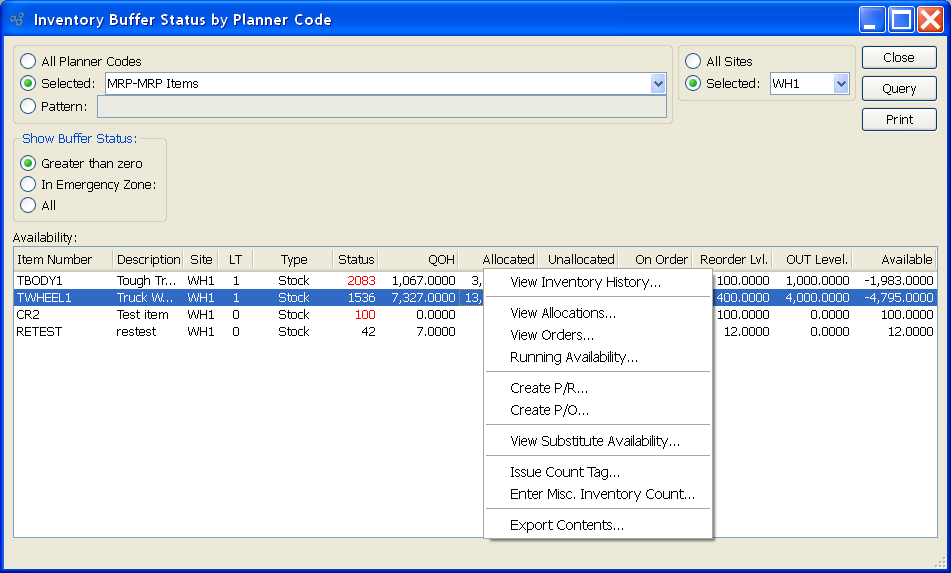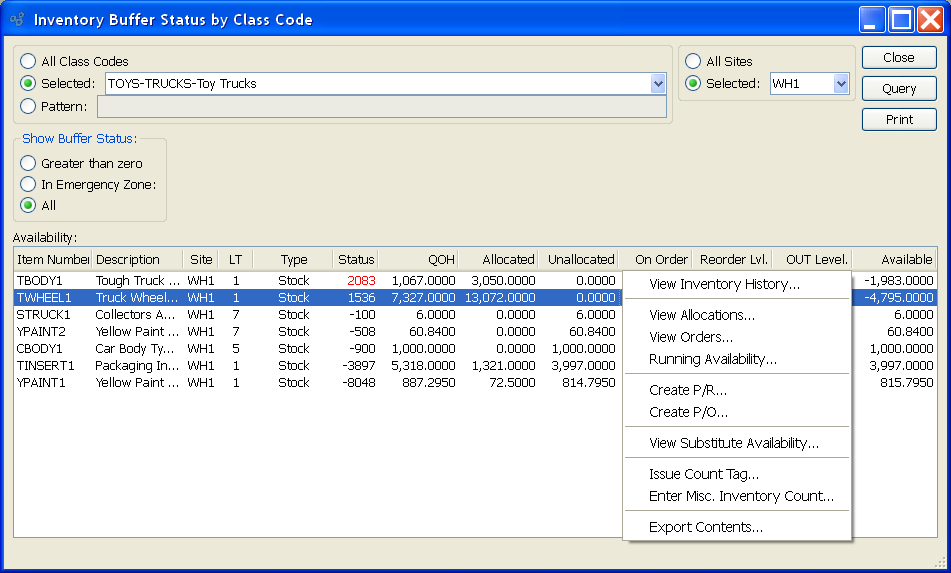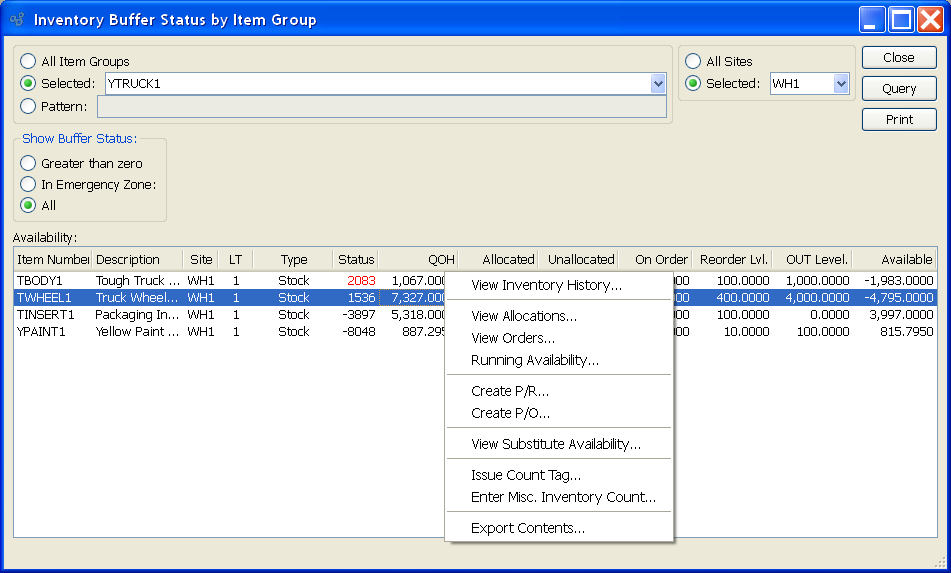Inventory Buffer Status section.
The Inventory buffer status displays provide information on your current stock buffer levels. Stock buffers apply to make-to-stock Items. Keep in mind that buffer status information will only be displayed on days when the Constraint Management system is run. If you find your displays show no information, this probably means Constraint Management has not been run.
To view Inventory buffer status by Planner Code, select the "Inventory Buffer Status by Planner Code" option. The following screen will appear:

Note
When the buffer status for an Item hits 66 or higher, the status number will become red. By highlighting Items which are "red hot," the system is informing you which Items should be acted on immediately. The best remedy for red hot Item Sites is to expedite any associated Work Orders or Purchase Orders.
When displaying Inventory buffer statuses by Planner Code, you are presented with the following options:
- All Planner Codes
Select to display Inventory buffer statuses for all Planner Codes.
- Selected
Specify Planner Code whose Inventory buffer statuses you want to display.
- Pattern
Enter a Class Code pattern to select a range of Planner Codes. Refine your search using Regular Expressions.
- Show Buffer Status
-
Show buffer statuses using one of the following criteria:
- Greater than zero
Select to display only those Item Sites having a buffer status greater than zero.
- In Emergency Zone
Select to display only those Item Sites whose buffer status is in the "emergency zone." The emergency zone is defined as a buffer status of 66 or greater.
- All
Select to display buffer statuses for all Item Sites.
- All Sites
Select to display Inventory buffer statuses for all Sites.
- Selected
Specify Site whose Inventory buffer statuses you want to display.
Note
By default, the display will sort Item Sites by buffer status in descending order. In other words, Item Sites with the highest buffer status will appear at the top of the list; Item Sites with the lowest buffer status will appear at the bottom.
- Availability
Display lists Inventory buffer status by Planner Code, using the specified parameters. If Planned Availability displays in the color orange, this means the actual or projected Quantity on Hand is at or below the Reorder Level. If the color is red, the current or projected Quantity on Hand is below 0.
Note
When quantity appears in the "On Order" column, this refers to quantity that is on order through either a Work Order or Purchase Order. In the case of Purchase Orders, the quantity will always be represented in the Inventory Unit of Measure (UOM)—regardless of the Vendor UOM used on the Purchase Order.
To the far right of the screen, the following buttons are available:
- CLOSE
Closes the screen, returning you to the application desktop.
- QUERY
Select to generate the display, using the specified parameters.
Runs the report associated with this screen.
Right-clicking on an Item in the Availability list enables you to select from the following context-sensitive menu options:
The following additional options are available for purchased Items:
The following additional options are available for manufactured Items:
The Inventory buffer status displays provide information on your current stock buffer levels. Stock buffers apply to make-to-stock Items. Keep in mind that buffer status information will only be displayed on days when the Constraint Management system is run. If you find your displays show no information, this probably means Constraint Management has not been run.
To view Inventory buffer status by Class Code, select the "Inventory Buffer Status by Class Code" option. The following screen will appear:

Note
When the buffer status for an Item hits 66 or higher, the status number will become red. By highlighting Items which are "red hot," the system is informing you which Items should be acted on immediately. The best remedy for red hot Item Sites is to expedite any associated Work Orders or Purchase Orders.
When displaying Inventory buffer statuses by Class Code, you are presented with the following options:
- All Class Codes
Select to display Inventory buffer statuses for all Class Codes.
- Selected
Specify Class Code whose Inventory buffer statuses you want to display.
- Pattern
Enter a Class Code pattern to select a range of Class Codes. Refine your search using Regular Expressions.
- Show Buffer Status
-
Show buffer statuses using one of the following criteria:
- Greater than zero
Select to display only those Item Sites having a buffer status greater than zero.
- In Emergency Zone
Select to display only those Item Sites whose buffer status is in the "emergency zone." The emergency zone is defined as a buffer status of 66 or greater.
- All
Select to display buffer statuses for all Item Sites.
- All Sites
Select to display Inventory buffer statuses for all Sites.
- Selected
Specify Site whose Inventory buffer statuses you want to display.
Note
By default, the display will sort Item Sites by buffer status in descending order. In other words, Item Sites with the highest buffer status will appear at the top of the list; Item Sites with the lowest buffer status will appear at the bottom.
- Availability
Display lists Inventory buffer statuses by Class Code, using the specified parameters. If Planned Availability displays in the color orange, this means the actual or projected Quantity on Hand is at or below the Reorder Level. If the color is red, the current or projected Quantity on Hand is below 0.
Note
When quantity appears in the "On Order" column, this refers to quantity that is on order through either a Work Order or Purchase Order. In the case of Purchase Orders, the quantity will always be represented in the Inventory Unit of Measure (UOM)—regardless of the Vendor UOM used on the Purchase Order.
To the far right of the screen, the following buttons are available:
- CLOSE
Closes the screen, returning you to the application desktop.
- QUERY
Select to generate the display, using the specified parameters.
Runs the report associated with this screen.
Right-clicking on an Item in the Availability list enables you to select from the following context-sensitive menu options:
The following additional options are available for purchased Items:
The following additional options are available for manufactured Items:
The Inventory buffer status displays provide information on your current stock buffer levels. Stock buffers apply to make-to-stock Items. Keep in mind that buffer status information will only be displayed on days when the Constraint Management system is run. If you find your displays show no information, this probably means Constraint Management has not been run.
To view Inventory buffer status by Item Group, select the "Inventory Buffer Status by Item Group" option. The following screen will appear:

Note
When the buffer status for an Item hits 66 or higher, the status number will become red. By highlighting Items which are "red hot," the system is informing you which Items should be acted on immediately. The best remedy for red hot Item Sites is to expedite any associated Work Orders or Purchase Orders.
When displaying Inventory buffer statuses by Item Group, you are presented with the following options:
- All Item Groups
Select to display Inventory buffer statuses for all Item Groups.
- Selected
Specify Item Group whose Inventory buffer statuses you want to display.
- Item Group Pattern
Enter an Item Group pattern to select a range of Item Groups. Refine your search using Regular Expressions.
- Show Buffer Status
-
Show buffer statuses using one of the following criteria:
- Greater than zero
Select to display only those Item Sites having a buffer status greater than zero.
- In Emergency Zone
Select to display only those Item Sites whose buffer status is in the "emergency zone." The emergency zone is defined as a buffer status of 66 or greater.
- All
Select to display buffer statuses for all Item Sites.
- All Sites
Select to display Inventory buffer statuses for all Sites.
- Selected
Specify Site whose Inventory buffer statuses you want to display.
Note
By default, the display will sort Item Sites by buffer status in descending order. In other words, Item Sites with the highest buffer status will appear at the top of the list; Item Sites with the lowest buffer status will appear at the bottom.
- Availability
Display lists Inventory buffer statuses by Item Group, using the specified parameters. If Planned Availability displays in the color orange, this means the actual or projected Quantity on Hand is at or below the Reorder Level. If the color is red, the current or projected Quantity on Hand is below 0.
Note
When quantity appears in the "On Order" column, this refers to quantity that is on order through either a Work Order or Purchase Order. In the case of Purchase Orders, the quantity will always be represented in the Inventory Unit of Measure (UOM)—regardless of the Vendor UOM used on the Purchase Order.
To the far right of the screen, the following buttons are available:
- CLOSE
Closes the screen, returning you to the application desktop.
- QUERY
Select to generate the display, using the specified parameters.
Runs the report associated with this screen.
Right-clicking on an Item in the Availability list enables you to select from the following context-sensitive menu options:
The following additional options are available for purchased Items:
The following additional options are available for manufactured Items: